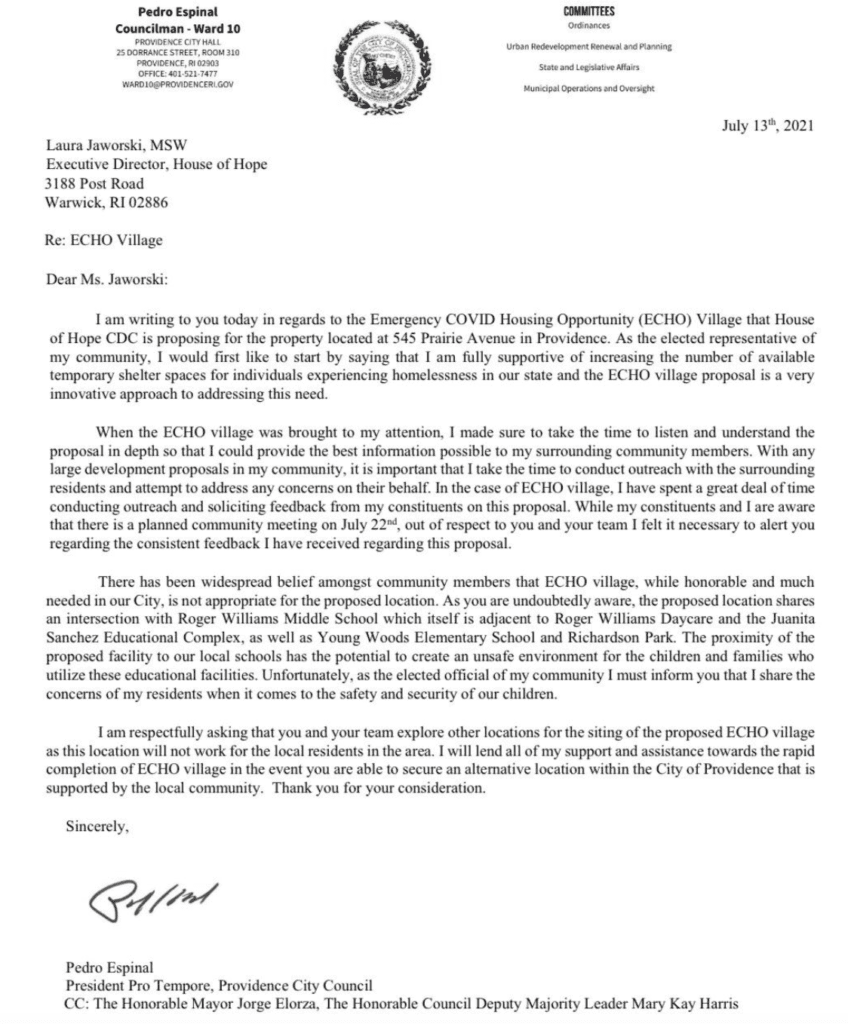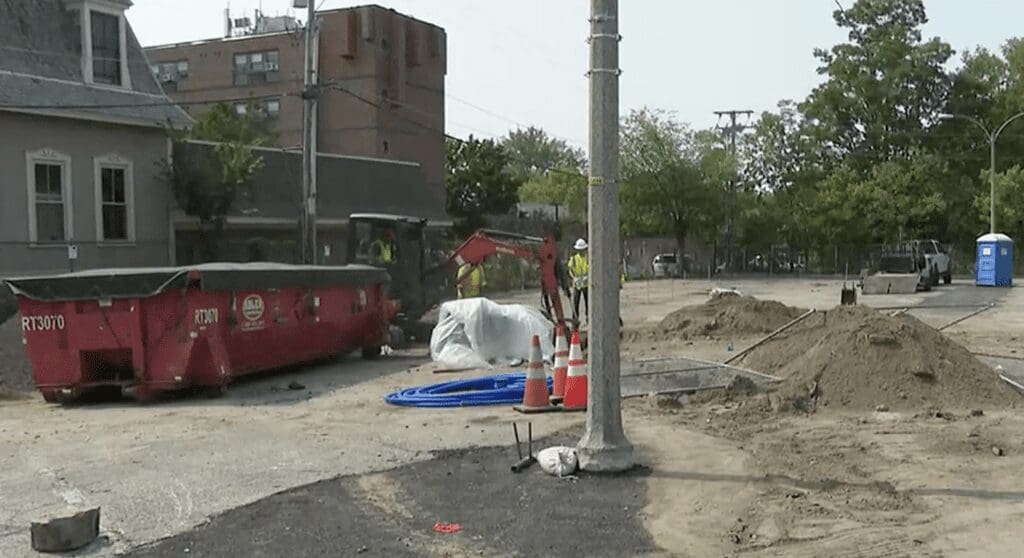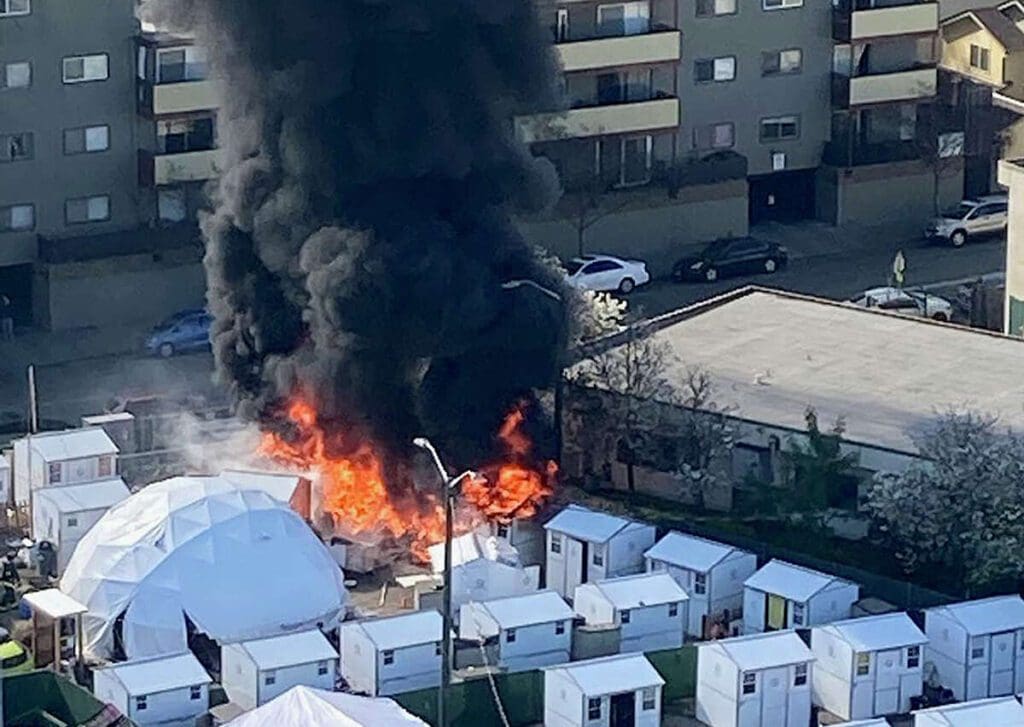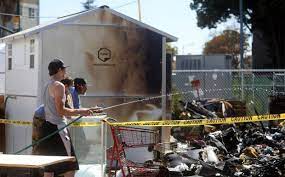Search Posts
Recent Posts
- Rhode Island Legislature Highlights Accomplishments for the 2025 Session June 25, 2025
- Sports in RI: Cody Tow, Volleyball Past, Present and Into His Future – John Cardullo June 25, 2025
- Need a Break? Time for Sour Grapes – Tim Jones June 25, 2025
- Rhode Island Weather Forecast for June 25, 2025 – Jack Donnelly June 25, 2025
- It is what it is: Commentary on 6.25.25 with Jen Brien June 25, 2025
Categories
Subscribe!
Thanks for subscribing! Please check your email for further instructions.

Pallet Shelters. Not here, not there, maybe not anywhere. No hotel takeovers. What’s next?
Photo from UpRise RI video, below, of community meeting last year in Olneyville
Rhode Island is taking its plan for using Pallet Shelters to provide emergency winter housing for the estimated 500 people in need. Housing officials have been quietly taking the project to local mayors and communities, looking for a home. But while this may be the first many have heard about Pallet Shelters – or tiny, temporary, pop-up housing units, they have been gaining in popularity around the country – but communities in Rhode Island remain resistant or regulations get in the way of an easy or quick implementation.
Over the last 1-2 years, several Rhode Island communities were considering Pallet Shelters. And there are some states with little villages set up. And one that brings safety into question.
Regardless of finding a community to locate Pallet Shelters, they can take up to 6 months to put up properly, on leveled land, and with utilities and services in place. Unless something changes dramatically, they do not appear to be a solution for this year’s winter season. With hotel take-overs out as an option because of last year’s bad experience with the NYLO Hotel in Warwick, as well, the fate of Rhode Island’s 500 hard to house individuals experiencing homelessness remains a question.
Rhode Island cities and towns
Pawtucket
Pawtucket had attempted to do this program in a 2021. They opted to work around the utility and bathroom hookup issue by putting the tiny houses inside a large warehouse. However, the fire department would not allow that physical arrangement and the program never moved beyond theory, even though the city purchased a warehouse for that purpose and holds it today under the Pawtucket Housing Authority – the unused “shelter” is at 1139 Main Street. The appraised value is approximately $265,000. The city paid $650,000 for the building, which remains vacant today. A request to the Pawtucket Housing Authority and the city of Pawtucket for information has not been answered.
South Providence
A failed attempt to put the Pallet Shelters in South Providence took place in July of 2021. The neighbors did not support it and came out in large numbers against it – this was captured by UpRiseRI in a series of videos when the housing group, House of Hope, tried to hold a productive meeting, partnering with the South Providence Neighborhood Association. The village would have been known as ECHO Village, with 30 Pallet Shelters, again, in a large warehouse. Over 200 people came out to oppose the idea. Read more here: https://upriseri.com/echo-village/ Here is the video featuring Laura Jaworski, director of House of Hope, who has told RINewsToday that there are no current plans under way for using Pallet Shelters, and none are in storage in Rhode Island waiting for the right location:
Rep. Espinal, local rep for the community noted, “This homeless shelter is yet another matter which disproportionately affects the residents of South Providence. This neighborhood is constantly facing new threats to public health and safety. From the proposed garbage transfer station in 2020, to the more recent proposal to expand storage of liquid propane gas in the Port of Providence, why must South Providence continue fighting these battles? While I believe that homeless shelters are needed in our city, I do not believe that building a shelter in close proximity to several schools, in a neighborhood with a number of other serious quality of life issues, is appropriate.”
Espinwall’s letter to House of Hope:

Olneyville area
While Olneyville was considered, and the project didn’t happen, ONE Neighborhood Builders went on to complete five 750-square-foot ‘net-zero energy’ homes.

The homes are topped by solar panels and were built in a South-facing arc to maximize solar production. Airtight and well insulated, the structures meet the “net-zero energy” standard, meaning they produce as much energy as they consume.” The modified units are part of the Tiny Home movement and ‘Tiny House Nation”. But no “Pallet Shelters” were ever built. The “designer” tiny homes had numerous construction challenges and a more traditional design is recommended.
City of Providence
Current Providence proposals for the Pallet Shelters appear to be not in consideration. However, yesterday the Mayor announced a plan to “reclaim” unused and abandoned city property for “affordable housing” so this may change. From Timothy Rondeau, Communications contact for Providence Planning said, “The State and City remain in regular contact to share updates on the availability and suitability of locations for affordable housing and shelter projects to address the urgent need. We are not aware of any locations actively being pursued in Providence for this type of project at this time.”
Cranston
Mayor Hopkins and Cranston City Council leadership came out sternly opposed to the only solid plan for Pallet Shelter use this year – that would be locating up to 500 Pallet Shelters on the Pastore Complex, a state owned property. The property is served by Cranston with municipal services including police, fire and rescue. There is some state payment for services to the existing complex, and prison, but it has been cut and has long said to be insufficient.
Noticably, land has been cleared for an undisclosed purpose at the Complex. Councilor Matt Reilly discovered the plan to locate the shelters there and sent out a press release while issuing a letter to the Governor.
State officials denied the plan was to local the shelters there, or anywhere. Mayor Hopkins reiterated that he felt that while they are saying that now, they will just wait for after the election to put their plan into action. Josh Saal, the state’s “Housing Czar” went on radio to say that it wouldn’t happen, and Mayor Hopkins responded, including telling how the city has had to pick up after the homeless who were sleeping in playground equipment tubes on Dyer Avenue, including cleaning up used syringes. Hopkins notes that locating shelters in some of the state parks that are closed for the winter may be a solution – they have bathroom and kitchen facilities – and mentioned Camp Cronin as an example.
Other Rhode Island cities/towns
A source said that Johnston has told the state they have no interest in them in the town. Warwick has said they have not been asked. No response from East Providence or Pawtucket about contact this year, at publication time.
___
Opening in Burlington, Vermont
After a six month delay, due to no one wanting to take the 30-pod project on, plans are underway for the Pallet Shelters to open in a parking lot. The development needs a managing group providing services, moving in and moving out, clean up, etc. The Champlain Housing Trust has taken it on. The group says they searched for months for a manager. Certain requirements must be met such as good behavior, willingness to engage with services, but as they build it out they are still unsure about substance use and if that will be a disqualifier. They are taking over a month to prepare the ground which needs to be cleared and leveled and hope to move people in to a downsized 25-pod area in late November. 5 more should be added by December.
Costs are estimated to be approximately $124 per pod, per client, per night. The management company will invoice the city for this amount and any other services.
See the video of the development, below – which is in a residential community:

In Denver, Colorado

In Denver, the use of Pallet Shelters is called “safe-camping”. A news reporter, who spent the night in one prior to them going “live” wrote about the shelter this way: “”I realized that I had many amenities not typically afforded to people sleeping in tents, tarps or sleeping bags on the streets of Denver. Since I could lock the door, I felt secure knowing that no one could walk into my shelter; my belongings were safe. And I also was able to use a nearby porta-potty in the middle of the night without worrying about a neighbor yelling at me or a cop handing me a ticket. I just did my business and went back to my bed.
Most important, having some personal space was liberating. I could be alone and relax. I could stay up as late or go to bed as early as I wanted. I didn’t have to move my bag in the morning, and could have left it there while I went to work.”
The cost for the Pallet Shelters is approximately $8,500 each. The Denver City Council approved allotting close to $4 million to the program in 2022. The goal is to house around 370 people in a total of four sites. In 2021, service providers were able to help transition 47 people from the sites into more stable housing.
Santa Cruz Pallet Shelters burn in 10 minutes
While fire concerns were expressed over the Pallet Shelters going into Pawtucket, and the reason was frustrating to local advocates, one city has seen just how dangerous it can be.


The use of 30 Pallet Shelters was part of a coordinated plan to address homelessness in Santa Cruz, California. Regardless of a safety protocol system consisting of periodic checks and controls, a fire started in one unit while a resident was away and in less than 10 minutes three units were completely engulfed. Safety measures include fire alarms and smoke detectors in each Pallet and rules banning combustibles, candles, flames, fires, cooking equipment and portable heaters inside, Kramer wrote in response to Sentinel questions. The village also has 24-hour onsite security. The units are primarily made of aluminum, fiberglass and plastic.
This is a developing story.
Past stories on Pallet Housing:

Thank you for following this story. A comment on another site stated that a local radio station said it was 20 to 30 ‘pallet houses’. I disagreed, pointing out that other sources, including the Governor, said otherwise. I’ve asked others to check the picture that you posted on 10/11 (?) of approximately 30 to 40 ‘pallets’ and try to imagine 500 of them in one place.
The picture showed little to no access for emergency vehicles, no fire hydrants, no lighting and more than enough trash.
This is the tip of the iceberg. I’m repeating myself (via a different site). Who is going to pay in perpetuity for this? The infrastructure (sewers, electric, etc.) would need to be rebuilt (site of institutions). Services need to be expanded (more police, fire, rescue & bodies w/more pay, benefits, etc., more equipment), trash pickup, sewer connections, water,and more. The logistics alone are mind-boggling.
Is the State paying the bills for the life of this, along with the above? Will this ‘project’ and associated expenses be included in the State budget every year it’s in existence? The legislature has already decreased Cranston’s funds from the ARPA so it’s doubtful it will approve the budget every single year of this. This will go by the wayside and Cranston will be paying the bills.
I’m fortunate but do feel for those going without. This isn’t a solution. The more that is given, the more people will want. Those who use Harrington Hall (approx. 150) will want their own pallet housing. It will never end.